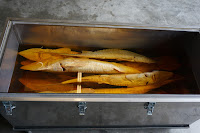Sadly, November 4 was our last trip to TNACI. For
this final trip, we learned about how ichthyologists are tracking endangered
species of fish, particularly the Pallid and Shovel Nose sturgeon, and how
they’re managing to prolong the survival of their species. The Pallid sturgeon,
which is indigenous to the northern Missouri and the waterways in that
vicinity, are dying out due to the construction of dams on the Mississippi.
As it turns out, the Pallid sturgeon has started interbreeding
with the Shovel Nose sturgeon. Since sometimes it is hard to tell which is
which when they interbreed, ichthyologists like Dr. Bernie Kuhajda are
currently trying to discern how many hybrids and purebreds are in nature by
comparing the fishes physical and genetic characteristics.
To determine the
physical qualities, he takes 39 measurements that include the distance from
head to tail and 9 counts such as the amount of rays on the lower fin. They
also use fin tags to track their movement.
Dr. K says that its tedious work but
necessary to determine how to protect the species. Although he loves his job
measuring fish, Dr. K also has a passion for cave fish found nowhere else
in he world. Some of his recent finds include the Alabama Cave fish, the
Southern cave fish, and the cave shrimp, which is found in only one Alabama
cave.
We took turns taking physical measurements and
counts as we learned about some characteristics of the Pallid and Shovelnose sturgeon.
Next, we took a short tour of the greenhouse,
which was holding Sewanee’s amphibian project. In this experiment, they were
testing competition amongst salamanders over a four week period, seeing if they
gain or lose weight when fed in a controlled environment.










No comments:
Post a Comment